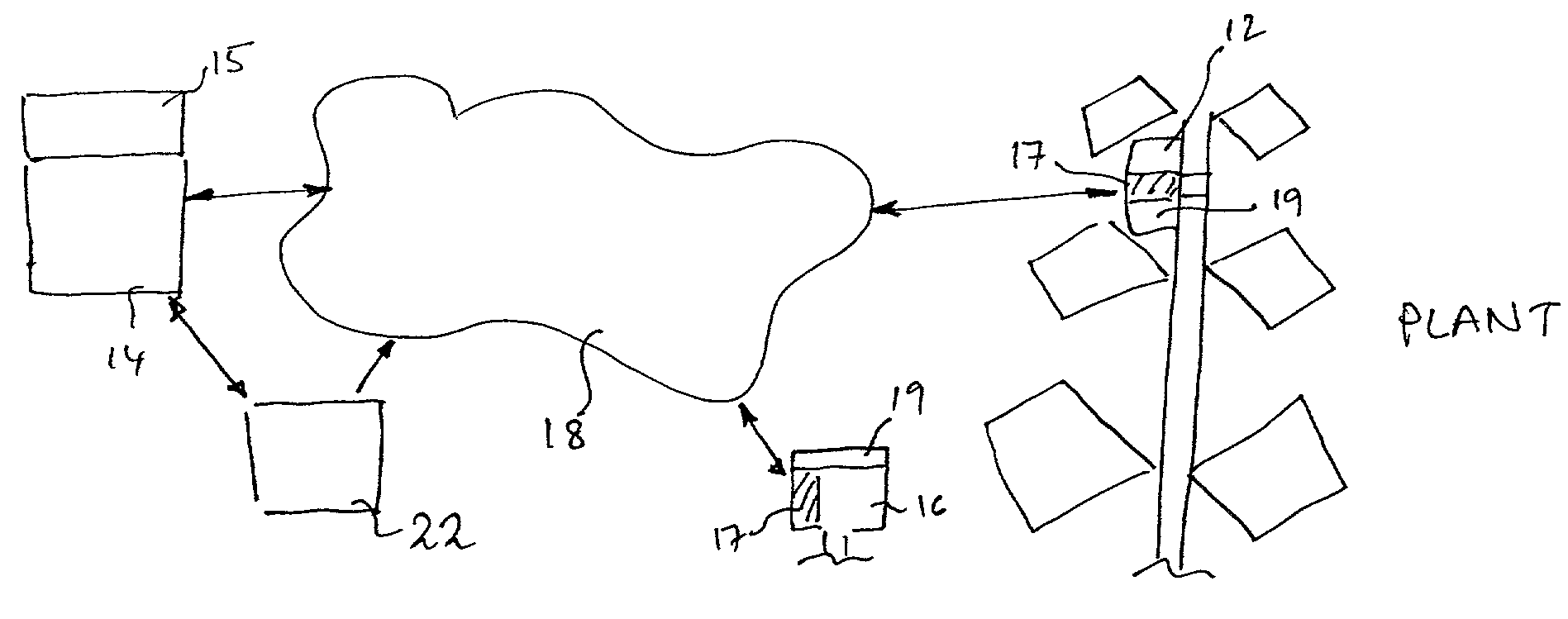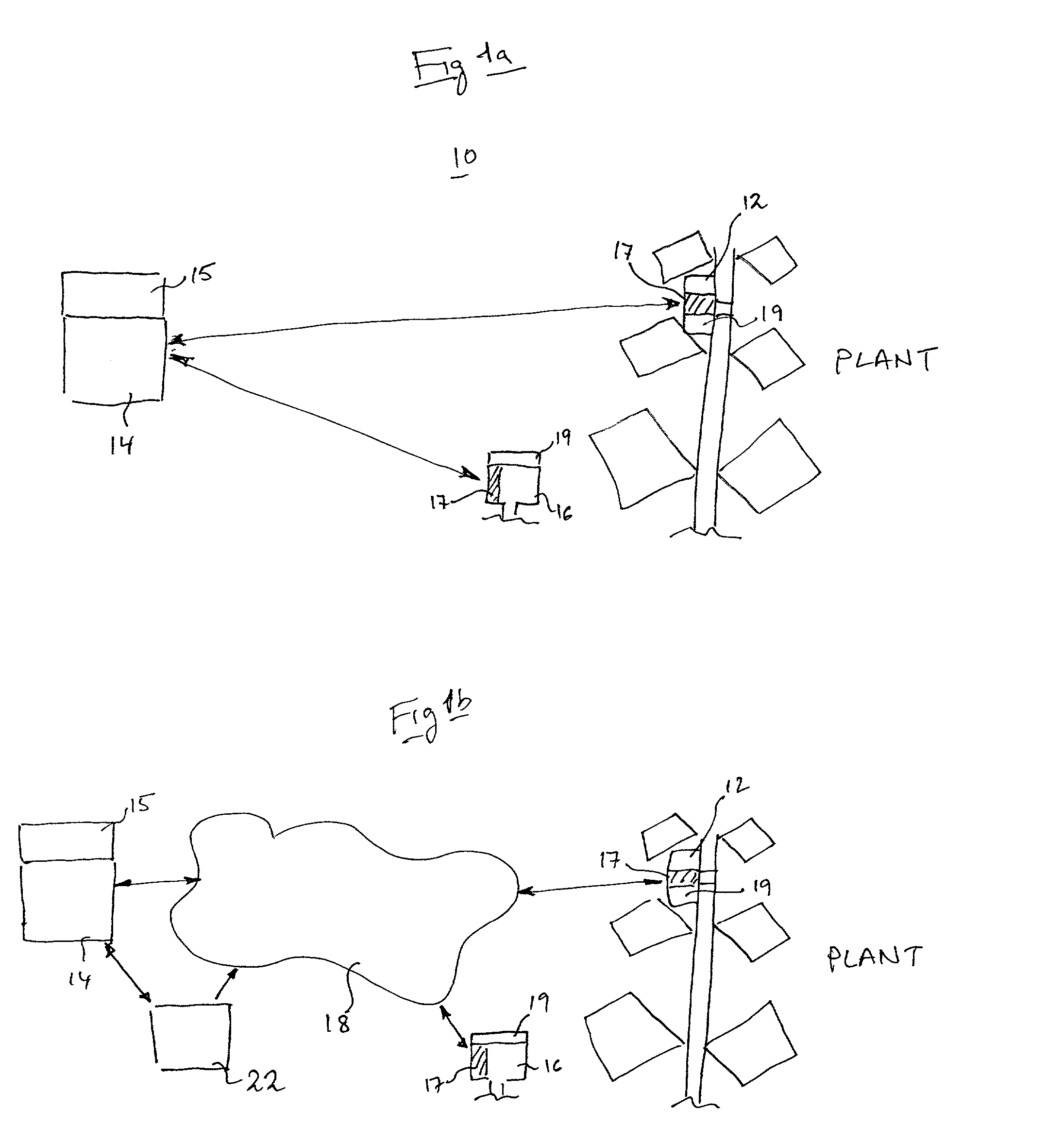System and method for phytomonitoring
a phytomonitoring and system technology, applied in the field of phytomonitoring system and method, can solve the problems of unavoidable crop loss, inability to accurately use information obtained from individual plants by such systems for predicting, and laborious and time-consuming visual inspection
- Summary
- Abstract
- Description
- Claims
- Application Information
AI Technical Summary
Problems solved by technology
Method used
Image
Examples
example 1
[0117] Plant Phytomonitoring
[0118] The phytomonitoring method of the present invention is effected by recognizing trend(s) in data collected from a plant and it's environment over a period of time.
[0119] As shown in FIG. 2, such a trend or trends can be graphically presented and used either individually or in combination to assess the plant condition in terms of "better", "worse" or "no change" (neutral) along a growth period of the plant.
[0120] Thus, the present invention allows to express plant and crop performance in relative, qualitative values, rather than absolute values which may not be available or which are difficult to interpret and / or correlate to an actual plant state and which, when collected from a representative plant or plants cannot be accurately utilized to asses the state of a crop.
[0121] As shown in FIG. 3, data is collected by a set of sensors positioned on a plant and in the environment thereof. The sensors used are selected such that the plant and environmenta...
example 2
Plant and Environmental Sensor Positioning
[0127] The sensors utilized by the present invention are positioned according to the following considerations:
[0128] Plant sensors:
[0129] (i) All of the sensors used are placed on various components of a single plant stem and their power and communications cables are attached to the shoot by an adhesive tape . . .
[0130] (ii) The leaf temperature sensor (e.g., LT-1, Phytech Ltd.) is placed on sunlit fully expanded leaf forming a part of the canopy top.
[0131] (iii) The sap flow rate sensor (e.g., SF-4, Phytech Ltd.) is placed at the leaf petiole in a position such that the total leaf area above the sensor is less than 50 cm.sup.2.
[0132] (iv) The stem diameter sensor (e.g., SD-5, Phytech Ltd.) is placed upon the lowest internode of the main stem.
[0133] Environmental sensors:
[0134] (i) The solar radiation sensor (e.g., TIR-4, Phytech Ltd.) is placed over the top of the leaf canopy.
[0135] (ii) The combined air temperature and humidity sensor (e.g...
example 3
Collection and Analysis of Sensor Data
[0137] Data pertaining to daily stem variations of a tomato plant was collected over a period of 3 days (FIG. 5).
[0138] Stem diameter change is caused by turgidity variations, which are influenced by water balance and osmotic regulation. As shown in FIG. 5, daily changes in stem diameter were observed over the measured time period, which resulted in a net increase in stem diameter. A daily stem diameter maximum is usually measured at predawn value; a daily change in stem diameter is calculated according to a subtraction of two sequential maximums.
[0139] FIG. 6 represents a stem diameter line graph generated from data collected from a tomato plant over a period of 2 days. Variations between maximums of the graph represent positive, neutral or negative trends in stem diameter changes.
[0140] Such trends are indicative of a plant state and can serve as objective assessment of crop disorders; this enables a grower to undertake certain cultivation ste...
PUM
 Login to View More
Login to View More Abstract
Description
Claims
Application Information
 Login to View More
Login to View More - R&D
- Intellectual Property
- Life Sciences
- Materials
- Tech Scout
- Unparalleled Data Quality
- Higher Quality Content
- 60% Fewer Hallucinations
Browse by: Latest US Patents, China's latest patents, Technical Efficacy Thesaurus, Application Domain, Technology Topic, Popular Technical Reports.
© 2025 PatSnap. All rights reserved.Legal|Privacy policy|Modern Slavery Act Transparency Statement|Sitemap|About US| Contact US: help@patsnap.com



